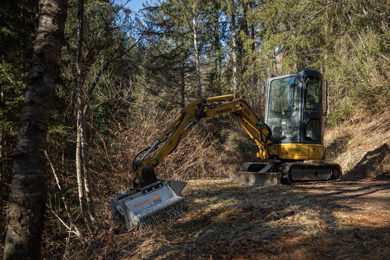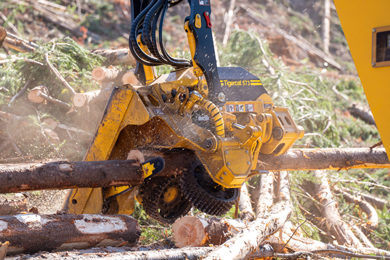Australian researchers have developed a world-leading genetic DNA testing system that can predict key commercial attributes of an adult eucalyptus tree from a single seedling leaf, and provide a strong return on investment to forest growers.
With research funding from Forest & Wood Products Australia (FWPA) and industry to validate the technology, this breakthrough could enable foresters to dramatically reduce the breeding cycle of Eucalyptus globulus (blue gum) and Eucalytpus nitens (shining gum) trees, significantly speeding up improvements to log quality.
Traditional breeding cycles are typically a decade or more, but modelling suggests the time can be halved with the new system and the genetic gains per year doubled or trebled, with a financial return of $8 for every $1 invested.
Unlike traditional crops, which have been bred over thousands of years and no longer resemble their wild forebears, eucalypts are genetically diverse, have long breeding cycles and are still close to their wild states – meaning the potential for gains are large.
The new system assesses the quality of a tree or seedling by DNA testing a 5mm hole punch of a leaf for thousands of genetic markers developed by CSIRO and correlated with commercial attributes. This project identified new genetic markers for wood density, and validated those, along with using previously-discovered markers for growth and pulp yield.
The researchers tested the DNA and commercial attributes of parent trees, and the DNA alone of their adult offspring. They used the DNA of the offspring to predict the parent’s commercial attributes – and the results proved to be highly accurate. Robert Southerton, the Managing Director of Gondwana Genomics, which was founded in 2014 and licensed the genetic markers from CSIRO, said researchers had not expected the high degree of accuracy of the genetic testing.
“Surprised is an understatement. We couldn’t believe it. We had to go back and check again and again, and the results held up,” he said. “In the past, we’d done similar research with a smaller group of genetic markers, and with slower testing techniques, and we’d had only mixed results.”
To make the breakthrough, the Gondwana Genomics research team developed a new method of cheaper, faster genetic DNA testing which enabled them to test over a thousand samples a day for less than $50 each instead of only 200 a day for over $100 each.
“If I’d known at the outset how many challenges we’d have to overcome to make this work, I would never have staked my house on setting up the business. The accuracies we have achieved would be considered very good in crops and it is phenomenal to get this in trees,” he said.
Trees, he explained, were exceptionally difficult to breed in the traditional manner for better genetics due to: a long cycle that means errors can creep in over time; difficulty separating out whether tree characteristics are genetic or environmental; and accidental pollination in planned cross-breeding.
Leveraging industry for ground-breaking trial
In total, the project screened over 11,000 seedlings from industry partners Forico, Australian Bluegum Plantations and HVP Plantations. Forico planted several hundred seedlings selected from almost 7000 screened – making for one of the first ever sizeable applications of marker assisted tree breeding in the world.
Research and Innovation Manager, Andrew Jacobs, said Forico had planted some seedlings identified via DNA as elite performers, as well as others at the middle and bottom end for comparison.
“At the moment, the DNA is predictive of quality, but the actual quality traits don’t start to really show until the tree is around the five-to-seven year mark,” he said. “In the meantime, we’ll continue to use this new technology in conjunction with our current methods. Down the track, when we’re more comfortable, I could see us moving further into this space.”
Forico decided to participate and invest in the trial because of its large and independent breeding program in nitens, he said. “We felt this technology could keep us at the forefront in terms of our breeding program given the success of the approach in other plants, and in animals.”
Maintaining genetic diversity, and other uses
In addition to identifying quality seedlings, the genetic profiling has a number of other potential applications including:
– Identifying seedlings that are genetically diverse for breeding – as inbred trees have greater pest and disease risk
– Accurately identifying a seedling’s parents
– Estimating inbreeding
– Creating a DNA fingerprint for a particular tree, eliminating the risk of mis-labelling
– Helping with ‘due diligence’ in valuing plantations
– Auditing existing tree improvement programs
– Breeding trees to combat specific risks, such as being disease-resistant.
Next steps
According to Robert Southerton, the next steps are demonstrating genetic differences within siblings in tree families, industry adoption of the new technology, exports and the potential to use their DNA testing method in other crops and, potentially, human research. Forico’s Andrew Jacobs also sees opportunities to identify DNA markers for other traits such as disease resistance, fertiliser use and resistance to stressors such as frost, heat and drought – and to further validate existing markers.
R&D Manager at FWPA, Chris Lafferty, congratulated the researchers and industry participants. “This is leading edge science, of great potential value to industry – and we’re proud to have played a part in terms both of funding and of facilitating this collaboration. It’s a prime example of the type of work we do at FWPA, investing industry levies and Commonwealth matching funds towards the generation of solutions to current and future challenges the industry will face.”
Photo: Credit: Andreachinn (Creative Commons)







